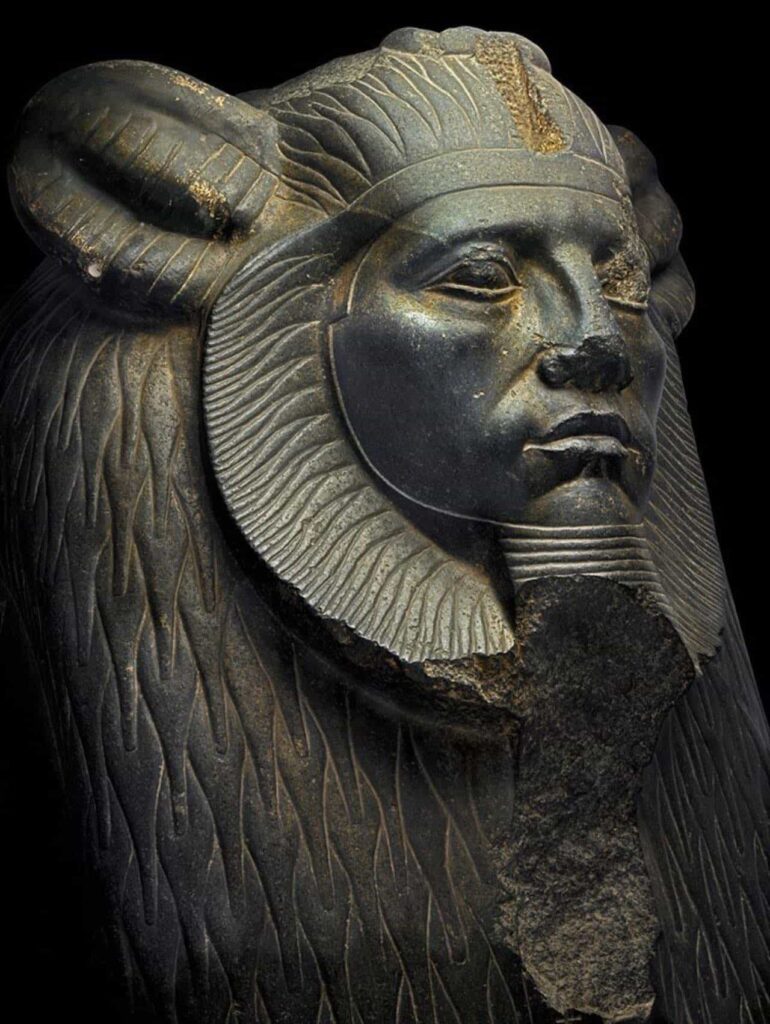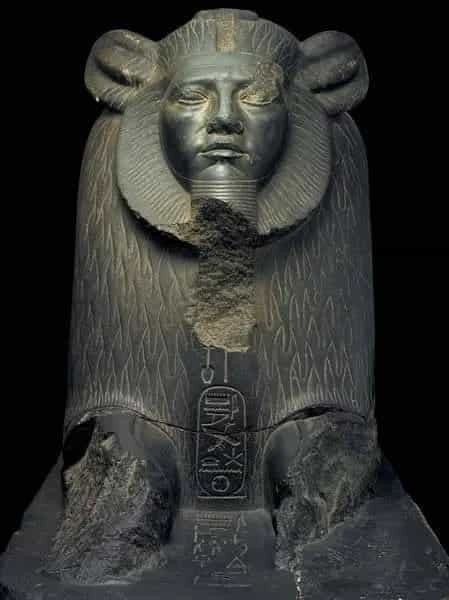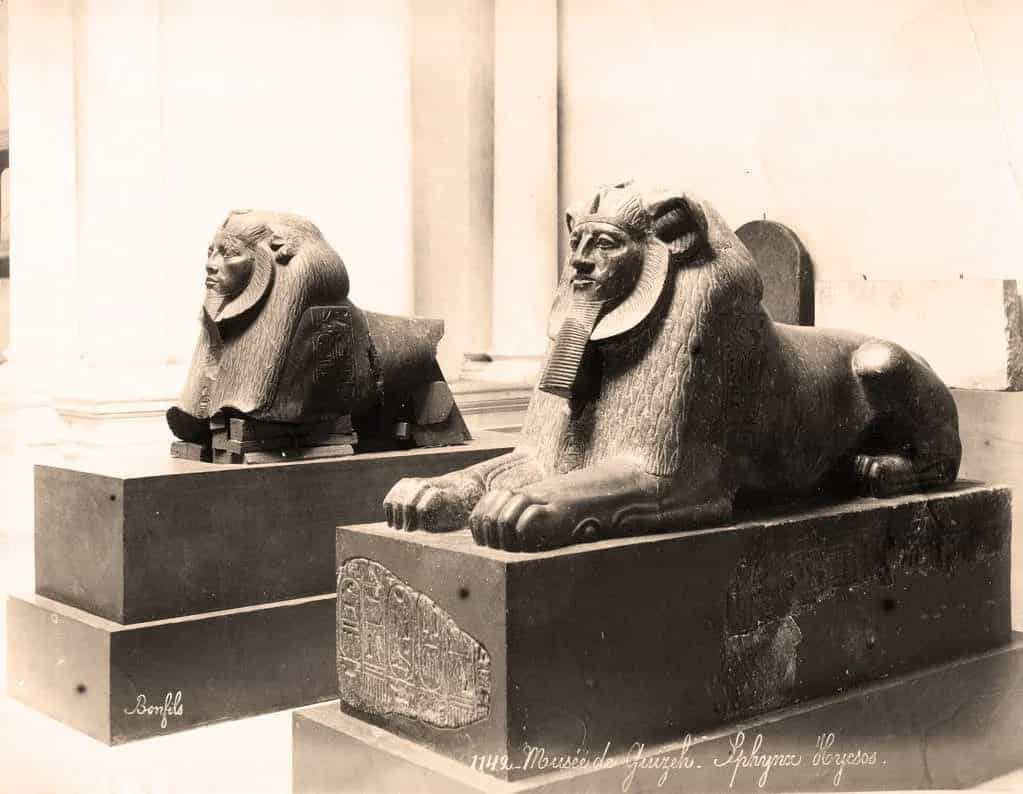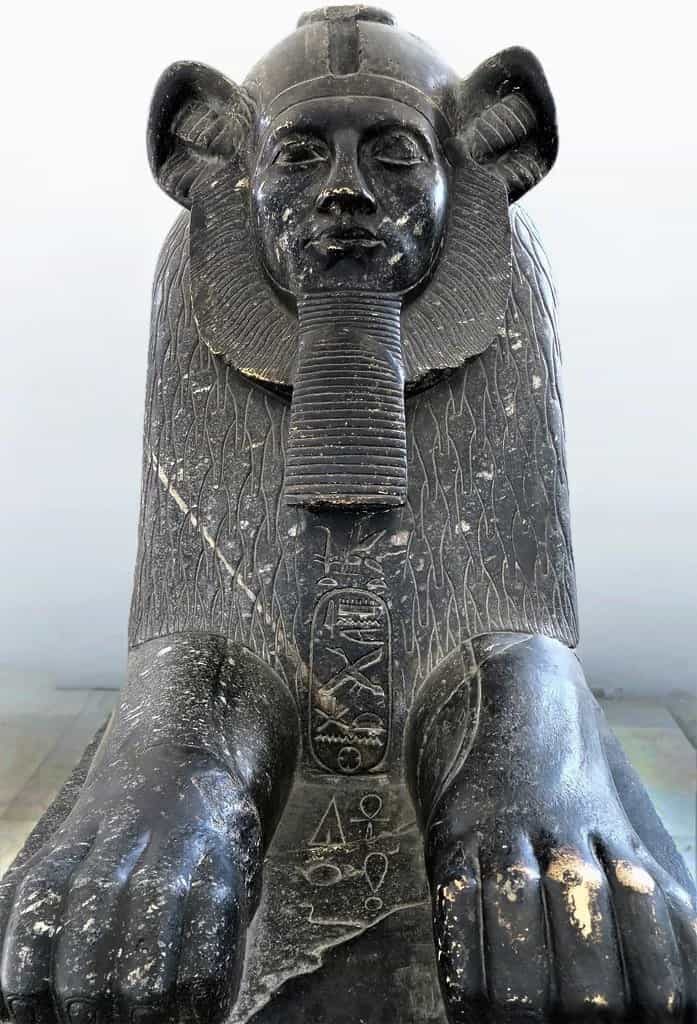
Amenemhat III, son of Senusret III, was the sixth pharaoh of the Twelfth Dynasty of ancient Egypt and is considered one of the great monarchs of the Middle Kingdom. He ruled between 1829–1799 BC.
During his peaceful reign, the king paid particular attention to the development of the Fayum area, where he was later deified and venerated.
He knew how to use peace to make the country more prosperous; this wealth is reflected in the king’s works.
From Tanis come the seven granite sphinxes of Amenemhat III, which evoke the monarch’s power.
Many statues of the sovereign remain. These statues recall the physical and spiritual evolution that show features of the face and the deeply human expression reflecting a strong character.
The face of the king, austere and vigorous, is characterized by the typical features of the royal portraitist—the prominent mouth and the deep furrows on the cheeks create strong chiaroscuro effects.
A massive lion’s mane, from which large ears sprout, replaces the traditional royal nemes and increases the figure’s sense of majesty.
There is also the uraeus on the forehead and a false beard, the usual symbols of divine royalty.
The statues rest on a high base around which are shown the cartouches of some sovereigns who, over the centuries, usurped the group of sphinxes: the Hyksos king Nehesy and Rameses II, Merenptah II of the 19th Dynasty, and finally Psusennes I of the 21st Dynasty.
The latter ruler finally placed the statues in Tanis, where they were found.
It is probable that the sphinxes were originally intended to decorate the temple of the goddess Bastet in Bubastis.
Construction activity
Amenemhat III ordered the erection of significant works, such as the extension of the Sobek temple in Shedet and the Hathor temple in Serabit el-Jadim.
He built a funerary complex with a pyramid at Dahshur called the “Black Pyramid.” The complex at Dahshur was used as a burial ground for the various wives of the king.
Around the fifteenth year of his reign, the pharaoh decided to erect his most lavish work: a new pyramid and its funerary complex, with a great temple and an annexed palace, built at Hawara, near El Fayum, later known as the “Labyrinth,” and described with great admiration by Herodotus, Diodorus Siculus, and Strabo, who praised it as one of the wonders of the World.
The pharaoh’s pyramid at Hawara contained some of the most complex security systems to be found in all of Egypt. However, the pharaoh’s sarcophagus was stolen in ancient times.

Twelfth Dynasty – Gray granite, Height 150 cm, Length 236 cm Tanis, Excavations by A. Mariette, 1863 Egyptian Museum in Cairo – JE 15210=CG 394



Sphinxes of King Amenemhat III from Tanis

Sphinx of King Amenemhat III
News
Unveiling the Ingenious Engineering of the Inca Civilization: The Mystery of the Drill Holes at the Door of the Moon Temple in Qorikancha – How Were They Made? What Tools Were Used? What Secrets Do They Hold About Inca Technology? And What Does Their Discovery Mean for Our Understanding of Ancient Construction Methods?
In the heart of Cusco, Peru, nestled within the ancient Qorikancha complex, lies a fascinating testament to the advanced engineering prowess of the Inca civilization. Here, archaeologists have uncovered meticulously angled drill holes adorning the stone walls of the Door…
Unveiling the Sun Stone: Aztec Relic from the Reign of Moctezuma II (1502-1520) – What Secrets Does It Hold? How Was It Used? What Symbolism Does It Carry? And What Does Its Discovery Reveal About Aztec Culture?
In the heart of Mexico City, amidst the bustling Plaza Mayor, lies a silent sentinel of ancient wisdom and artistry – the Sun Stone. This awe-inspiring artifact, dating back to the reign of Moctezuma II in the early 16th century,…
Uncovering the Past: Rare 1,000-Year-Old Copper Arrowhead Found – Who Crafted It? What Was Its Purpose? How Did It End Up Preserved for So Long? And What Insights Does It Offer into Ancient Societies?
In the realm of archaeology, every discovery has the potential to shed light on our shared human history. Recently, a remarkable find has captured the attention of researchers and enthusiasts alike – a rare, 1,000-year-old copper arrowhead. This ancient artifact…
Unveiling History: The Discovery of an Old Sword in Wisła, Poland – What Secrets Does It Hold? Who Owned It? How Did It End Up There? And What Does Its Discovery Mean for Our Understanding of the Past?
In a remarkable archaeological find that has captured the imagination of historians and enthusiasts alike, an old sword dating back to the 9th-10th century AD has been unearthed in Wisła (Vistula River) near Włocławek, Poland. This discovery sheds light on the rich…
Unveiling the Hidden Riches: Discovering the Treasure Trove of a Notorious Pirate – Who Was the Pirate? Where Was the Treasure Found? What Historical Insights Does It Reveal? And What Challenges Await Those Who Seek to Uncover Its Secrets?
A group of divers said on May 7 that they had found the treasure of the infamous Scottish pirate William Kidd off the coast of Madagascar. Diver Barry Clifford and his team from Massachusetts – USA went to Madagascar and…
Excavation Update: Archaeologists Unearth Massive Cache of Unopened Sarcophagi Dating Back 2,500 Years at Saqqara – What Secrets Do These Ancient Tombs Hold? How Will They Shed Light on Ancient Egyptian Burial Practices? What Mysteries Await Inside? And Why Were They Buried Untouched for Millennia?
Egypt has unearthed another trove of ancient coffins in the vast Saqqara necropolis south of Cairo, announcing the discovery of more than 80 sarcophagi. The Tourism and Antiquities Ministry said in a statement that archaeologists had found the collection of colourful, sealed caskets which were…
End of content
No more pages to load











